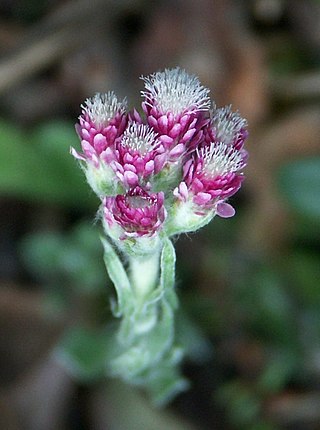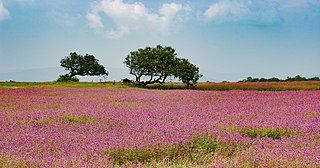
Trifolium repens, the white clover, is a herbaceous perennial plant in the bean family Fabaceae. It is native to Europe, including the British Isles, and central Asia and is one of the most widely cultivated types of clover. It has been widely introduced worldwide as a forage crop, and is now also common in most grassy areas of North America, Australia and New Zealand. The species includes varieties often classed as small, intermediate and large, according to height, which reflects petiole length. The term 'white clover' is applied to the species in general, 'Dutch clover' is often applied to intermediate varieties, and 'ladino clover' is applied to large varieties.

Ranunculus repens, the creeping buttercup, is a flowering plant in the buttercup family Ranunculaceae, native to Europe, Asia and northwestern Africa. It is also called creeping crowfoot and sitfast.

In biology, stolons, also known as runners, are horizontal connections between parts of an organism. They may be part of the organism, or of its skeleton. Typically, animal stolons are exoskeletons.

Antennaria dioica is a Eurasian and North American species of flowering plant in the family Asteraceae. It is a perennial herb found in cool northern and mountainous regions of Europe and northern Asia (Russia, Mongolia, Japan, Kazakhstan, China, and also in North America.

Tiarella cordifolia, the heart-leaved foamflower, is a species of flowering plant in the family Saxifragaceae. The specific name cordifolia means "with heart-shaped leaves", a characteristic shared by all taxa of Tiarella in eastern North America. It is also referred to as Allegheny foamflower, false miterwort, and coolwort.

Miliusa is a genus of plants in family Annonaceae. Species have been recorded from tropical and subtropical Asia to northern Australia.

Ratheesh was an Indian actor best known for his work in Malayalam cinema. He was a native of Kalavoor in the Alappuzha district of Kerala, India. He performed villainous roles during the 1990s. He had acted in 158 films with directors such as K. G. George, I. V. Sasi, Joshiy, P. G. Vishwambharan, Thampy Kannamthanam, Sreekumaran Thampi, Rajasenan,P.K.Joseph and Shaji Kailas. Unlike other villains of the time, Ratheesh captivated the Malayalam movie lovers with his charms and handsome looks.He attained superstardom for a brief while during the 80s.

Rotala is a genus of plants in the loosestrife family. Several species are used as aquarium plants.
John C. Jacob was one of the pioneers of the environmental movement in Kerala, India.

Lekhayude Maranam Oru Flashback is a 1983 Malayalam-language film by K. G. George and produced by Innocent. The film was controversial because of the protagonist's similarities to the actress Shoba, whose suicide was highly publicized. In his biography, even though KG George admits that his inspiration to make the movie was indeed the suicide of Shobha, he says that more importantly it was his long-time dream to make a cinema about 'cinema', which had never been tried before in the Malayalam industry at the time.

Lilium wallichianum is an Asian species of bulbous plants in the lily family native to the Indian Subcontinent and to Myanmar. It is native to India, as well as Nepal, Bhutan, and Myanmar.

Romeo is a 2007 Malayalam romantic comedy film written by Rafi Mecartin and directed by Rajasenan, starring Dileep, Vimala Raman, Sruthi Lakshmi, and Samvrutha Sunil in the lead roles. Romeo was a commercial success at the box-office.

Edavalath Kakkat Janaki Ammal (formally known as Janaki Ammal) (4 November 1897 – 7 February 1984) was an Indian botanist who worked on plant breeding, cytogenetics and phytogeography. Her most notable work involved studies on sugarcane and the eggplant (brinjal). She also worked on the cytogenetics of a range of plants and co-authored the Chromosome Atlas of Cultivated Plants (1945) with C.D. Darlington. She took an interest in ethnobotany and plants of medicinal and economic value from the rain forests of Kerala, India. She was awarded Padma Shri in 1977.

Lokpal is a 2013 Indian Malayalam-language vigilante thriller film written by S. N. Swamy and directed by Joshiy. The film stars Mohanlal as chef Nandagopal who leads a double life with an alter ego named Lokpal, a vigilante fighting against corruption. Kavya Madhavan, Meera Nandan, Manoj K. Jayan, Thambi Ramaiah, and Sai Kumar play supporting roles. The soundtrack was composed by Ratheesh Vegha. The film was released on 31 January 2013.

The Kas Plateau Reserved Forest, also known as the Kaas Pathar, is a plateau situated 25 kilometres west from Satara city in Maharashtra, India. It falls under the Sahyadri Sub Cluster of the Western Ghats, and it became a part of a UNESCO World Natural Heritage Site in 2012.

Red Wine is a 2013 Indian Malayalam-language thriller film directed by Salam Bappu and written by Mammen K. Rajan from a story by Noufal Blathoor. It stars Mohanlal, Fahad Faasil and Asif Ali. The film's soundtrack and background score were composed by Bijibal. Red Wine was released on 21 March 2013. The film was later dubbed into Telugu under the same title.

Sonerila is a genus of plants in the family Melastomataceae. This genus is characterized the by presence of three petals as opposed to five in the other members of the family. Most members of the genus prefer growing in shady habitats. It is a large genus including about 175 species.

Kallai FM is a 2018 Indian Malayalam-language drama film written and directed by Vineesh Millennium. Dialogues were written by Sreenivasan, who also starred alongside Sreenath Bhasi and Parvathy Ratheesh. The film is based on the real-life story of a radio repairer named Radio Koya residing at Mankavu, Kozhikode, who was an ardent fan of singer Mohammed Rafi.

Maniyarayile Ashokan is a 2020 Indian Malayalam-language romantic comedy film directed by Shamzu Zayba. The film stars Jacob Gregory and Anupama Parameswaran. The cast also includes Krishna Sankar and Shine Tom Chacko. The film was produced by Gregory and Dulquer Salmaan in his newly established production company Wayfarer Films. He made a cameo appearance along with Nazriya Nazim and Anu Sithara as other characters.

Sonerila margaritacea is a species of flowering plant in the genus Sonerila, native to Myanmar. An evergreen perennial with patterned leaves, reaching only 10 cm, it has gained the Royal Horticultural Society's Award of Garden Merit as a terrarium or hothouse ornamental.


















